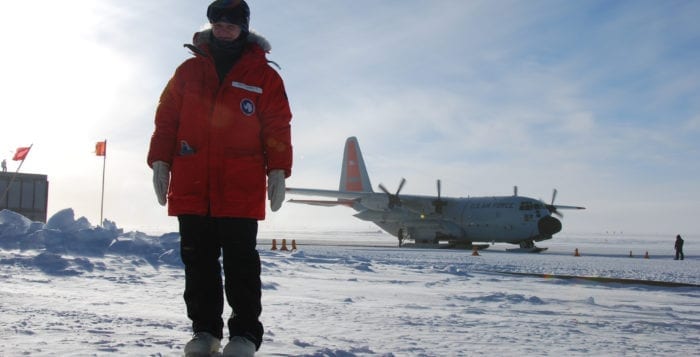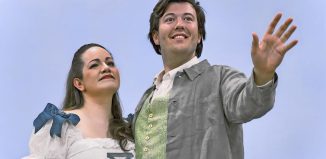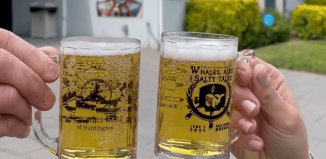By Daniel Dunaief
She traveled to a place she felt might have been as unfamiliar as visiting the moon or Mars. The project that is such a large part of her life is looking for signals sent from well beyond those relative celestial neighbors.
Joanna Kiryluk, an assistant professor of physics at Stony Brook University, didn’t travel off the planet, although she visited a remote location that was considerably different, less populated and at a higher altitude than the sandy beaches of Long Island. In 2009, Kiryluk traveled to the South Pole as a part of the aptly named IceCube project, which was completed in 2010. Kiryluk and hundreds of other physicists around the world are studying the information gathered from detectors drilled deep into the ice below the surface.
Kiryluk is studying tau and electron neutrinos, which are created as products of cosmic ray interactions and carry very high energies. Scientists do not know which sources in the universe are capable of creating such high energies. Unraveling this is one of her research goals. The neutrinos produced by collapsing stars, or supernova, typically have energies that are about a million times smaller than the high-energy neutrinos discovered by IceCube.
Neutrinos have very small masses and travel at speeds close to the speed of light, Kiryluk explained. Since they interact with matter weakly, they pass through most objects without any interactions. On rare occasions, however, these neutrinos collide with a neutron or a proton, causing a characteristic reaction that provides a clue about where they are, what energy they had when they collided, and, perhaps where they originated.
For her research, Kiryluk recently received the prestigious National Science Foundation Career Award, which provides almost $900,000 to support her work over the next five years. “It’s a great honor,” said Kiryluk. “The chances of success for such proposals are small and, in this sense, it was also a pleasant surprise.” Kiryluk said the funding will enable her to employ two graduate students per year. Part of the money will also be used for educational purposes and outreach. Kiryluk has reached out to high schools including Brentwood and Riverhead High School to involve students and teachers in research. Kiryluk is also a proponent of a Women in Science and Engineering program, or WISE, that encourages the “involvement of under-represented groups” in science, including women.
Kiryluk credits her Ph.D. advisor, Barbara Badelek, a professor at the University of Warsaw in the Department of Physics and a professor at Uppsala University, for believing in her and in her ability. She suggested that such support was critical to her success and her focus. Badelek met Kiryluk in 1994 and supervised her undergraduate and Ph.D. work. Kiryluk was “immediately recognized as a remarkably good student: hard working, trying to achieve a deep understanding of problems and very enthusiastic,” Badelek explained in an email. Badelek added that she is “very pleased to see her maturity and growing scientific prestige.”
In the IceCube project, Kiryluk is a part of an experiment that involves over 300 scientists from 48 institutions from around the world. IceCube, which took seven years to build, was manufactured as a discovery experiment to find high-energy neutrinos, which originate from astrophysical sources. People who have known Kiryluk for decades suggest that she has the right temperament for such an ambitious joint effort.
Kiryluk is “quiet and calm, but works hard and never leaves things because she finds some difficulties,” explained Ewa Rondio, the deputy director for scientific matters at the National Centre for Nuclear Research in Poland, who met Kiryluk when she was an undergraduate. Kiryluk’s goal is to measure the energy spectrum of these neutrinos. “We are interested in fluxes,” she said. These fluxes and energy spectra of high-energy neutrinos will provide insights in the sources and mechanisms of the most powerful accelerators in the universe.
A cubic kilometer of ice, IceCube, which has enough water to fill one million swimming pools, is large enough to capture more of these rare neutrino events. The key to unraveling what these signals indicate is to understand their energy and direction. The detectors don’t collect information from the neutrinos directly, but, rather from the interaction with particles in the ice. The neutrino interactions in ice produce a flash of light in the South Pole ice that the scientists measure with sensors. They study the pattern, the arrival times and the amplitude of this light at the sensors. This information can help determine the neutrino energy and direction.
Kiryluk is looking for high-energy events that are “most likely coming from outside of our galaxy,” she said. These particles are distributed all over the sky. While IceCube is capable of collecting data from the highest energy particles, it hasn’t yet gathered enough of these events to provide conclusive information at this range.
Kiryluk visited the South Pole for two weeks in 2009 before IceCube was finished. She was involved in the commissioning of the newly deployed detectors for the data acquisition system. The detectors are between 1,500 and 2,600 meters deep, which helps them “suppress any background events,” such as cosmic rays that are produced in the atmosphere. The facility is 3,000 meters high and has low humidity, which means it’s “easy to get dehydrated,” Kiryluk said. She described the working and living conditions at the South Pole as “modern.”
A native of eastern Poland, Kiryluk arrived on Long Island in 2001, when she worked at Brookhaven National Laboratory. She lives in Rocky Point. Kiryluk said the physics department is “growing.” Since her hire, nine assistant professors have joined the Department of Physics and Astronomy at Stony Brook University. As for her work, Kiryluk is inspired to understand how IceCube can be used as a “probe to study astronomy,” which enables her to be a part of the process of discovering “what is out there.”







